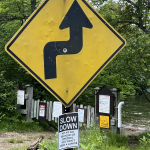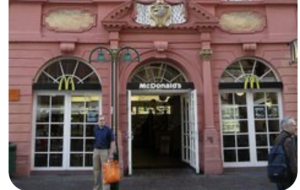Chapter 4: Interpreting Place and Cultural Landscape
4.3 Interpreting Cultural Landscapes and Exercises
When you’re interpreting landscapes consider examining the following aspects or layers and how they reveal the past, reflect the present, and shape the future of any given place:
The natural landscape
- Are there forested areas? Were trees removed or were they replanted in a regular manner? is there a garden-like ‘man-made’ natural landscape?
- Are there water systems present such as any running water rivers, brooks? Is there a lake that may have induced settlements?
- What is the role of natural elements in the shaping of the built environment?
- How have human systems and infrastructure been adapted to the environment?
Infrastructure
Infrastructure shapes the cultural landscape by influencing how people interact with their environment and each other. It is a visible marker of how human societies organize themselves, adapt to their surroundings, and express cultural identity.
- Roads, bridges, and the general transportation networks dictate the flow of movement and trade, often determining the layout of towns and cities. T
- he design and architecture of buildings, from residential homes to public institutions, reflect cultural values, historical influences, and technological advancements.
- Water and energy systems, such as canals, dams, and power lines, illustrate how societies harness natural resources, impacting both the physical and social environment.
- Public spaces, parks, and recreational areas show the cultural importance of communal gathering and leisure.
Toponyms
Toponyms, or place names, are deeply embedded in the cultural landscape, serving as markers of historical, cultural, and social significance.
- They often reflect the history of a region, commemorating events, influential figures, or indigenous heritage. For example, street names, neighborhoods, or cities might bear the names of local heroes, historical events, or natural features, preserving collective memory and identity.
- Toponyms can also reveal the linguistic and cultural diversity of a place, indicating the influence of different ethnic or cultural groups over time. For instance, a mix of names from different languages within a city may highlight its multicultural history.
- In addition to their historical and cultural significance, toponyms can shape perceptions and interactions with the landscape. Names often carry connotations that influence how people relate to a place, whether it be a sense of pride, nostalgia, or even discomfort.
Overall, toponyms are more than just labels on a map; they are narratives that connect people to their environment, reflecting the values, histories, and identities of the communities that inhabit the landscape.
Local Customs
Local customs are often visibly integrated into the cultural landscape, manifesting in both the physical environment and social behaviors.
- The way people use and interact with public spaces, such as parks, plazas, and markets, reflects local customs. For instance, in some cultures, public squares might be bustling with social activities, while in others, they might be quiet places for reflection. The presence of communal gathering spots, like tea houses or cafes, can indicate customs of socializing and hospitality.
- How people navigate streets and sidewalks can reveal cultural norms. In some areas, strict adherence to traffic rules, such as stopping at crosswalks and following pedestrian signals, reflects a culture of order and respect for rules. In other places, more flexible or informal approaches might indicate a different set of social expectations. In some cultures, crossing a street on a crosswalk might be accompanied by music playing.
- The design and decoration of buildings can showcase local customs, such as religious practices or seasonal celebrations. For example, homes might display specific symbols, flags, or colors that reflect cultural or religious beliefs. The presence of shrines, murals, or community art also communicates shared values and traditions.
- Cultural landscapes often transform during local festivals, where streets and public spaces might be decorated with lights, banners, or other festive elements. Temporary markets, stages, or parades take over the streets, reflecting the community’s customs and shared celebrations.
- The layout and organization of markets, as well as the types of goods sold, can reflect local customs around food and trade. For instance, the prominence of street food stalls, the types of foods offered, and the way people interact with vendors all provide insights into culinary traditions and social customs.
- Signage in public places, such as the use of multiple languages or specific dialects, can indicate linguistic customs. The way people greet each other, whether with handshakes, bows, or other gestures, may also be evident in public spaces.
- The clothing people wear in public, whether traditional attire or modern fashion, can reflect and express their identity across generations and cultures.
- Religious customs are often visible in the landscape through places of worship, such as churches, mosques, temples, or shrines. The regular use of these spaces, along with processions or rituals that spill into public areas, highlights the community’s spiritual practices.
In essence, local customs leave a tangible imprint on the cultural landscape, offering a visual and behavioral map of a community’s values, traditions, and social norms.
Other material and immaterial culture (see section below)
Exercise: Core-domain-sphere model
Think of a culture and/or way of life with which you have familiarity–perhaps this is gaming culture, farming culture, urban culture, etc. Apply the core-domain-sphere model to your case study.
- How well does the core-domain-sphere model apply to your case study? Describe a specific example of a cultural aspect that fits with the model and another aspect that diverges from it. If you don’t think the model applies at all, discuss why that might be. Are there aspects of contemporary society and how culture diffuses that might limit the utility of this model nowadays, or not?
Another way to approach landscape interpretation is by paying special attention to artifacts, sociofacts, and mentifacts which are essential components of a culture, each representing different aspects of human societies:
- Artifacts are tangible objects created by humans that reflect the technology and material culture of a society; for instance, pottery from ancient civilizations, smartphones in modern societies, or traditional clothing like the Japanese kimono.
- Sociofacts represent the social structures and relationships within a culture, such as family dynamics, educational systems, and government institutions; an example is the caste system in India, which dictates social interactions and hierarchy.
- Mentifacts are the intangible elements of culture, encompassing beliefs, values, and ideas; examples include religious beliefs like Christianity, democratic ideals, and philosophical concepts like Confucianism. Together, these elements shape and reflect the complexities of human cultures.both material and nonmaterial culture.
Material culture relates to the various tangible objects made and used by culture. Many of these material artifacts are given meaning by the culture and can even change over time. Nonmaterial culture- often referred to as mentifacts – refers to intangible ideas that cultures have that are not tied directly to material objects. These beliefs are often attached to place. In addition, sociofacts bridge the material and nonmaterial culture. For example, a textbook is an artifact (if a book) but its purpose is that of educating which relates to the social educational system of a place.

Source: Photo by Barbara Crain, CC BY 4.0.
To illustrate: The church building shown in Figure 4.3.1 is a small, historic church in Norway, exemplifying an artifact. Within its walls, activities such as prayers, masses, and candle lighting take place, representing sociofacts passed down through the church’s leadership. The underlying religion, Christianity, serves as the mentifact, conveying the core values and beliefs of the community.

Photo by Barbara Crain, CC BY 4.0
Reading the landscape using language: Spoken languages, such as conversations, songs, jokes, and other intangible elements of culture, are examples of mentifacts that can be heard. Language also becomes visible in the landscape through written signs, which are tangible artifacts of culture. These signs, with their words or symbols, offer an excellent opportunity to practice interpreting the landscape. However, it’s important to note that the words on these signs do not always convey the same story as the landscape they inhabit.

Photo by Barbara Crain, CC BY 4.0.
The diffusion of cultural traits often leaves visible imprints on the landscape. A keen observer can look at a place and discern how various cultural forms have been layered over time. This layering is sometimes particularly noticeable, for instance, when an old building is demolished and replaced with a new structure that clashes with the existing architectural style of the area. Sometimes it is more subtle. Figure 4.3.3 shows an image of the US fast-food chain McDonalds situated in the middle of Heidelberg’s Old Town, Germany. McDonalds was not permitted to use its yellow arches-instead the windows are arched and the yellow M is almost (not quite) invisible. .
Exercises
Let’s use these ideas culture traits (i.e. using artifacts, sociofacts and/or mentifacts) to read cultural landscapes. The United Nations Educational, Scientific and Cultural Organization (UNESCO) has a list of cultural landscapes. The following short videos show several of these landscapes. Try and answer the questions that you can find underneath each video to deepen your understanding.
- How can we tell that a large political/national change occurred within this landscape?
- Which cultural groups (Taliban, Buddhists) did which things to the landscape?
Questions (for video: Blaenavon Industrial Landscape (UNESCO/NHK))
- How has history, time, and scale impacted this landscape?
- How has the local culture changed over time vis-à-vis the labor and treatment of both children and horses?
Questions (for video: Agricultural Landscape of Southern Öland (UNESCO/NHK))
- What do fences tell us about the culture? About the geography of this location?
- Do the people living here use indigenous/traditional methods and knowledge, or new methods and knowledge?
Questions (for video: Rice Terraces of the Philippine Cordilleras (UNESCO/NHK))
- Names of places and objects have importance on the cultural landscape. What does the language and naming in this landscape tell us about the local history and tradition?
- Discuss the form and function of the terrace structures. What cultural ideas are reflected in these structures?
- How is local infrastructure adapted to the agricultural practices in the video?
Questions (for video: Agave Landscape and Ancient Industrial Facilities of … (UNESCO/NHK))
- Tequila often has a Declaration of Origin, which certifies that the product is from Mexico and produced according to strict guidelines. What does a Declaration of Origin tied to a drink tell us about cultural identity?
-
Cultural syncretism is the blending and merging of different cultural elements, resulting in new, hybrid cultural products, processes, and beliefs. Identify and discuss the evidence of cultural syncretism you observe in this video.
Questions (for video: Koutammakou, the Land of the Batammariba (UNESCO/NHK))
- What do the Western clothing and artifacts tell us?
- What is the relationship between people and livestock and how is that reflected or revealed in the landscape?

